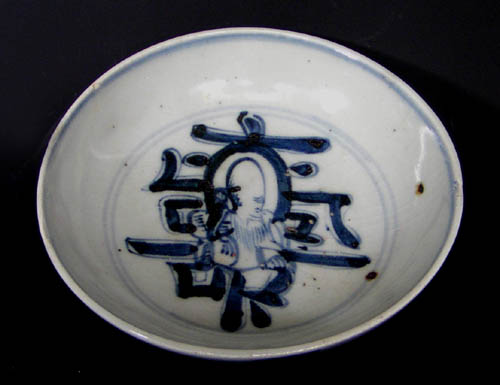
Symbolism in Ming Blue and white Ceramics
¡¡
The Chinese have uniquely developed a method to express complex ideas through motifs in folk art. The key elements include:
 |
|
| Hongzhi blue and white dish with Shoulao and shou character. |
Below is an exploration of the symbolism found in some Ming blue and white wares produced by folk kilns (minyao).
Wishes of the Common Folk
In an agricultural society where human labor is vital for farming, having many male offspring¡ªespecially sons to carry on the ancestral line¡ªhas long been treasured. This value is reflected in ceramic decorations featuring infants.
|
Hongzhi bowl with infants motif |
Another popular motif on late Ming wares shows an infant riding a qilin (also spelled chilin). The qilin is an auspicious, unicorn-like mythical creature that, according to legend, appeared during the reigns of the wise and benevolent emperors Yao and Shun. As time passed and the creature disappeared from the world, the qilin became associated with auspicious omens, virtue, and illustrious offspring¡ªmaking it a favored decoration on porcelain wares.
|
Wanli Jar with an infant on a Qilin |
Chenghua/Hongzhi plate with a Qilin |
¡¡
Other common wishes are conveyed through various objects:
Aspirations of the Literati Class
Scholars pursued Confucian ideals, aspiring to serve through official careers. Motifs reflecting success include:
|
Wanli/Tianqi bowl with official/deer motif |
Jiajing/wanli dish illustrating a rebus with bee/monkey and deer and the emblematic object pine tree |
For scholars disillusioned by bureaucracy, motifs celebrated reclusive refinement. This life is defined by the cultivation of the Four Arts: the qin (a string instrument), chess, calligraphy, and painting, which together epitomize the ideal gentleman.
|
Tianshun/Chenghua Bowl decorated with the "Three friends of winter" motif, symbols of strength in adverstiy and longevity |
Hongzhi bowl showing the lotus motif - the lotus risinh from mud symbolizes the ability to resist corruption and maintain moral purity. |
Religious Symbols
From Emperor Yongle through to Hongzhi, many emperors were devout Buddhists, and Buddhist symbols became popular in this period.
These elements are often interwoven with floral scrolls on early and mid-Ming bowls, particularly along the inner mouth rim. Although the auspicious objects can sometimes be drawn in a rudimentary fashion, their symbolic meanings remain multi-layered.
Another object commonly found on 15th-century Ming blue and white ceramics is the Vajra. Resembling a thunderbolt, the Vajra is the emblem of the divine force in Buddha's doctrine¡ªone that shatters all false beliefs and ignorance.
|
Xuande/Zhengtong bowl with floral scroll and Sanskrit characters |
Chenghua/Hongzhi bowl with floral scroll interspersed with Buddhist auspicious objects and sanskrit characters on the inner mouth rim |
After Emperor Zhengde, Jiajing¡ªwho was a fervent Taoist seeking the elixir of longevity (ironically, mercury was a key ingredient and likely contributed to his demise)¡ªsaw the rise in popularity of Taoist symbols on Ming blue and white ceramics.
These objects are portrayed as magical tools used by the Eight Immortals to overcome evil forces. Additionally, scenes depicting Penglai¡ªthe fabled Taoist ¡°island of the immortals¡± represented by three mountains rising from a sea of waves¡ªare also common.
Written by NK Koh. Edited with ChatGPT and Deepseek (6 Feb 2025)